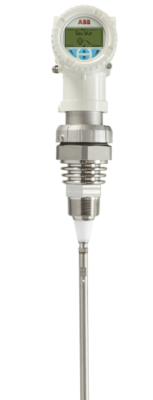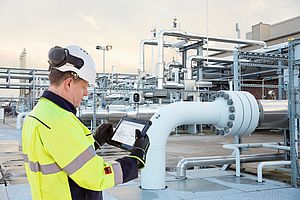Describing the novelty of the innovation, Nicolas Ho, ABB’s Global Product Manager for laser and guided-wave radar level measurement says “ABB is tapping into two mega-trends: digitalization as a productivity enhancer and the increasing scarcity of skilled labour. The new devices can be installed by instrument technicians in a fraction of the time that previous models required and with the confidence that they will work perfectly from day one. That’s especially important when a new tank farm with four or six tanks gets fitted out because the instrument technician will want to complete the installation within a day and return to base. These benefits are proving to be highly attractive in the cost-conscious 2020’s, especially with the latest down-draft in the price of crude oil that we have seen around the world since early March”.
Multi-phase level measurement made easy
Since its launch in 2019, hundreds of instruments in the LWT family have been adopted by end users around the world. Many are being used in the onshore upstream oil and gas sector where the most common application for guided wave radar level measurement is in crude oil storage tanks at remote oil well locations. These tanks receive a multi-phase mixture of crude oil and water from the nodding donkey well-head and they perform an initial physical separation between these two liquid phases. Level monitoring in the crude storage tanks is essential to efficiently schedule the crude oil collection transportation vehicles. Good logistics management can avoid inefficient part-loads or costly down time resulting from enforced production stoppages if the storage tanks get too full. Beyond that, measurement of the water level underneath the oil layer is important to ensure that the water can be pumped off and the available tank storage capacity can be used for the valuable crude oil. “Some of the early adopters of the LWT310 instrument, which is the new model configured for liquid applications”, continues Ho, “have had the chance to conduct multiple installations and use the product in the field for several months. Their feedback confirms that the reduced installation times are saving money and they are equally enthusiastic about the reliability and accuracy of the level readings”.
The principle of operation relies on the radar wave partially reflecting from the upper crude oil layer and partially penetrating to the oil-water interface, where it is then reflected from the water layer. Water is extremely reflective so the radar beam cannot penetrate further to detect additional interface layers such as a sandy solids phase in the tank base can be detected. If the full three phase measurement is required, which may be the case in other types of application, then a nuclear radiation device must be used alongside the guided wave radar. However, the associated complexity and precautions associated with this type of instrumentation must be considered carefully before taking that route.
Chemical inventory management with micro-precision
The new generation LWT300 series also has a new embedded proprietary electronic algorithm to increase the level measurement accuracy and temperature compensation. The accuracy achievable with the new series is better than 2mm, taking these devices to the top of the league table for that specification. As far as the temperature compensation goes, innovative electronics and digital algorithms have resulted in improved measurement stability which is an order of magnitude better than the previous industry standard.
These accuracy benefits come to the fore when the guided wave radar level gauge is used for tank contents inventory management in the chemicals sector. For high value corrosive liquids, such as acids or molten sulphur, there are few choices for non-invasive level measurement and these applications are the home turf of guided wave radar level measurement instruments. However, with high value products in large diameter tanks, a few millimetres of level can equate to several thousand dollars-worth of inventory. So, high precision measurement is essential to ensure reliable book-keeping and fair product transfer valuations and invoicing. So, being able to rely on chemical storage tank level readings with a precision within a few millimetres can be a big deal.
Powders and solids too
As a rule of thumb, for every four guided wave radar level instruments used for liquids, there is typically one more that is used for the measurement of dry solids - generally meaning powders. These tend to be materials-handling and storage applications in the metals processing, chemicals, food and pharmaceutical sectors. With no moving parts to malfunction, the guided wave radar technology is ideal for situations where corrosive powders may be kicked up into the storage tank head space during mixing or product transfer.
Moreover, the guided wave radar measurement principle offers the possibility to ‘see through’ dense dust or thick misty vapours and this is one of its main advantages when compared to non-contact level measurement techniques. This unique ability to find the true level is a key differentiator that has placed the guided wave radar technique in a league of its own. Highly sought-after attributes such as this have led to it being one of the fastest growing instrumentation categories in the various process industry sectors in recent years.
Intelligence inside
Since the guided wave radar technique is so versatile, instruments have been used in diverse applications from liquids to slurries, powders and two-liquid situations. That versatility has, unfortunately come with a usability penalty: setting up these instruments has been a technically complex task and that has been their main limitation since their introduction about two decades ago. Specialist expertise has generally been called in to do the installation, configuration and, in many cases, a follow-up trouble-shooting visit. All in all, the installation labour and service costs have often exceeded the instrument hardware cost by a factor of two.
This is the pain point that ABB have sought to resolve with the incorporation of the LevelExpert™ into the new LWT300 series. It is a powerful set of algorithms allowing the instrument to be configured by the input of some basic information about the application from various pre-set menu options which the installation technician can configure either from the device touch screen of from a computer connected to the level gauge. Significant setup time and cost reductions are the result. This intelligence built into the device might just be the catalyst to transform the reputation that this type of equipment has of being ‘easy to install’ in addition to robust and reliable in long term service. This will significantly widen its field of application and broaden its popularity and acceptance in existing applications.






















